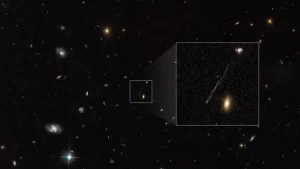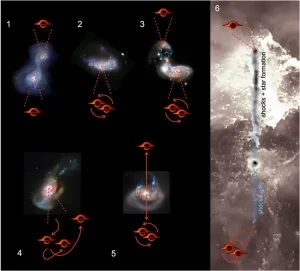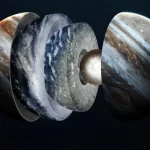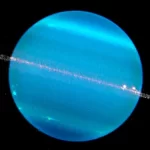Key Takeaways:
- Astronomers may have discovered a runaway black hole, 20 million times the mass of the Sun, leaving a trail of newly formed stars in its wake.
- The observed black hole’s stellar trail, extending over 200,000 light-years, suggests that supermassive black holes can be ejected from their parent galaxies.
- The black hole’s presence was initially identified by an unusual linear streak linking it to a distant galaxy, captured by the Hubble Space Telescope.
- The stellar wake, though thin, is filled with hot blue stars, making it almost half as bright as the parent galaxy.
- The proposed scenario involves a complex dance between three supermassive black holes during galaxy mergers, leading to the ejection of the observed black hole.
Astronomers have made a remarkable discovery, indicating the presence of a black hole approximately 20 million times the mass of the Sun, rapidly moving away from the core of a distant galaxy. This colossal supermassive black hole, as it travels through intergalactic space, is exerting pressure on the sparse gas and dust in its path, resulting in the formation of a slender trail of newly born stars extending over a staggering distance of about 200,000 light-years.
According to Pieter van Dokkum from Yale University, who was the first to identify this trail of stars, it appears that behind the black hole, there exists a wake where the gas cools down and facilitates star formation. Analogous to the wake left by a ship, this phenomenon is akin to observing the aftermath of the black hole’s journey.
Despite its relatively slender appearance, the stellar wake produced by the black hole is teeming with hot blue stars, rendering it nearly half as luminous as the galaxy from which it originated. Based on the available data, researchers speculate that this black hole might have been ejected during a complex interplay involving three supermassive black holes during a series of galaxy mergers. If verified, this would mark the first observational proof of supermassive black holes being expelled from their host galaxies.
Detailed findings regarding this candidate runaway black hole and its stellar wake were published in The Astrophysical Journal Letters.
Black holes, despite their invisibility, often leave behind visible traces of their presence. For instance, many black holes are encircled by dense disks of swirling, intensely heated gas and dust, known as accretion disks, which emit substantial amounts of light, thereby betraying the presence of the black hole.

However, in this case, it was not an accretion disk but rather an unusual linear streak connecting it to a nearby galaxy that caught the attention of van Dokkum. Initially spotted in an image captured by the Hubble Space Telescope, the streak was later confirmed to be associated with the galaxy through follow-up observations conducted with the Keck Observatory in Hawaii.
Van Dokkum described the discovery as serendipitous, as he stumbled upon it while examining the Hubble image for an unrelated purpose. Initially dismissing it as a potential imaging artifact, further scrutiny revealed its persistence even after eliminating cosmic rays, indicating its genuine nature.
The researchers considered the possibility of the streak being an astrophysical jet emanating from the black hole core of the nearby galaxy, a common occurrence in such systems. However, the streak’s intensity increases as it moves away from the galaxy’s core, and it does not disperse at its end, leading the researchers to conclude that it is, in fact, a trail of newly formed stars.
Moreover, at the outermost end of the streak, where the suspected black hole is believed to be located, evidence of a shock wave preceding the black hole was also observed. This shock wave results from the high-velocity impact of the black hole moving through the surrounding gas at supersonic speeds.

The astronomers hypothesize that this runaway black hole was likely expelled from its parent galaxy following two successive galaxy mergers in the relatively recent past. The initial merger, occurring approximately 50 million years ago, resulted in the two galaxies’ supermassive black holes entering into orbit around each other.
Subsequently, a later merger involving a third galaxy initiated a chaotic dance among the three supermassive black holes, ultimately leading to the solitary black hole’s ejection from the system. The researchers also predict that when the isolated black hole was expelled, the remaining pair of binary black holes should have been propelled in the opposite direction.
To validate this hypothesis, the team intends to conduct further observations using the James Webb Space Telescope and the Chandra X-ray Observatory.


